

Views: 600 Author: sales@insightknife.com.cn Publish Time: 2025-01-07 Origin: Site








Content Menu
● Understanding Knife Sharpness
>> The Importance of Sharp Knives
● Common Causes of Dull Steak Knives
>> Improper Cutting Techniques
>>> Using the Wrong Cutting Surface
>>> Blade Design
>>> Lack of Regular Sharpening
● Best Practices for Maintaining Sharp Steak Knives
>> Regular Sharpening and Honing
● Frequently Asked Questions regarding Steak Knives
>> 1. What is the best way to sharpen steak knives?
>> 2. How often should I sharpen my steak knives?
>> 3. Can I use a dishwasher to clean my steak knives?
>> 4. What type of cutting board is best for maintaining knife sharpness?
>> 5. How can I tell if my steak knife is dull?
Steak knives are essential tools in any kitchen, designed to slice through meat with ease. However, over time, these knives can become dull, making them less effective and even dangerous to use. Understanding the common causes of dull steak knives can help you maintain their sharpness and prolong their lifespan. This article will explore various factors that contribute to dullness, including improper usage, storage practices, and maintenance techniques.
A sharp knife is not only more efficient but also safer to use. Dull knives require more force to cut through food, increasing the risk of slipping and causing injury. When a knife is sharp, it glides through meat, allowing for clean cuts that preserve the texture and flavor of the dish. This is particularly important when serving steak, as a clean cut can enhance the overall dining experience by allowing the juices to remain intact and the meat to be more tender. Additionally, using sharp knives can reduce fatigue during meal preparation, making cooking a more enjoyable experience.
Dullness in steak knives can result from several factors, including the materials used in the knife, how it is used, and how it is stored. Recognizing these causes is the first step in preventing dullness and ensuring your knives remain effective. Understanding the science behind knife sharpness can also provide insights into how to care for your tools better. For instance, the angle of the blade edge and the type of steel used can significantly influence how long a knife stays sharp.
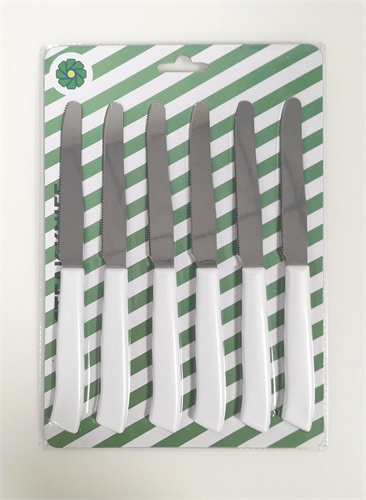
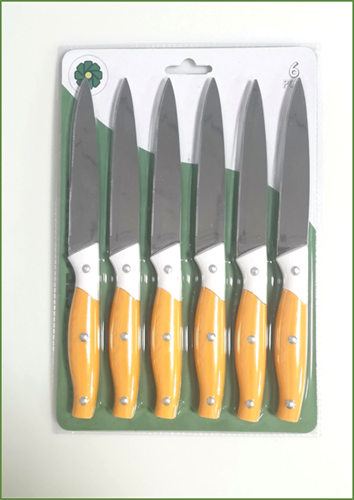
One of the most significant contributors to dull steak knives is the cutting surface. Using hard surfaces like glass or stone can quickly dull the blade. These surfaces do not provide any give, which means the knife edge can chip or wear down more rapidly. Instead, opt for softer cutting boards made of wood or plastic, which are gentler on the knife's edge. Wooden boards, in particular, have natural properties that can help maintain the sharpness of the blade while also being more hygienic than plastic boards, as they can self-heal from cuts and are less likely to harbor bacteria.
The way you cut can also affect the sharpness of your knife. Using a sawing motion instead of a smooth slicing action can lead to premature dullness. It is essential to use a consistent, smooth motion when cutting to maintain the knife's edge. Practicing proper technique not only preserves the knife but also improves your efficiency in the kitchen. Learning to slice with the grain of the meat can also enhance the quality of the cut, making it easier to chew and more enjoyable to eat.
The quality of the steel used in steak knives plays a crucial role in their sharpness and durability. Low-quality stainless steel may dull more quickly than high-carbon steel, which retains its edge longer. High-carbon steel is often favored by professional chefs for its ability to hold a sharp edge, but it requires more maintenance to prevent rust. Investing in high-quality knives can significantly reduce the frequency of sharpening needed. Additionally, understanding the differences between various types of steel can help you choose knives that best suit your cooking style and preferences.
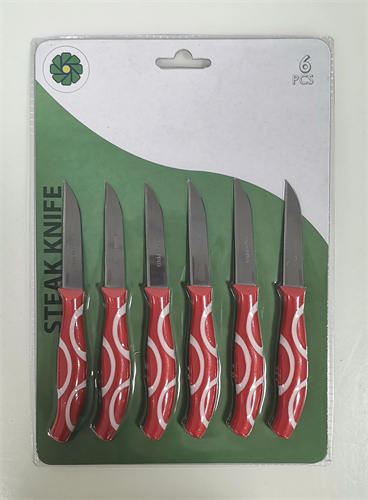
The design of the blade can also impact its sharpness. Knives with serrated edges may stay sharp longer than straight-edged knives, but they can be more challenging to sharpen. Serrated knives are excellent for cutting through tougher surfaces, such as crusty bread or thick cuts of meat, but they may not provide the same precision as straight-edged knives. Understanding the type of blade you have can help you choose the right maintenance techniques. For instance, straight-edged knives may require more frequent honing, while serrated knives may only need occasional sharpening.
Regular sharpening is essential for maintaining the sharpness of steak knives. Failing to sharpen your knives can lead to dullness over time. It is advisable to sharpen your knives every few months, depending on usage. Some chefs recommend using a whetstone for a more precise sharpening process, while others may prefer electric sharpeners for convenience. Regardless of the method, establishing a routine for sharpening can help ensure that your knives remain effective and safe to use.
Honing is often confused with sharpening, but it serves a different purpose. Honing realigns the blade's edge, while sharpening removes material to create a new edge. Regular honing can help maintain sharpness between sharpening sessions. Many chefs recommend honing their knives before each use to ensure optimal performance. Using a honing rod can be a quick and effective way to keep your knives in top condition, allowing for smoother cuts and reducing the need for frequent sharpening.
Storing steak knives in drawers without protection can lead to dullness. When knives are jostled against other utensils, the blades can become nicked and dull. Instead, consider using a knife block, magnetic strip, or protective sheaths to keep your knives safe. Proper storage not only protects the blades but also ensures that they are easily accessible when needed. A well-organized kitchen can enhance your cooking experience and make meal preparation more efficient.
Moisture can lead to rust and corrosion, which can dull the blade. Always ensure that your knives are dry before storing them, and avoid leaving them in the sink or submerged in water for extended periods. Additionally, consider using a desiccant or moisture-absorbing materials in your knife storage area to help keep humidity levels low. This simple step can significantly extend the life of your knives and maintain their sharpness.
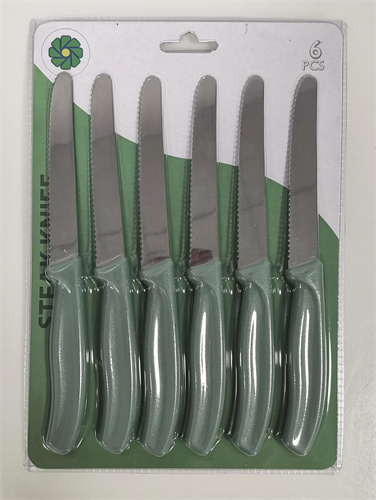
Certain cleaning products and chemicals can react with the metal in knives, leading to dullness and corrosion. It is essential to wash your knives by hand with mild soap and water, avoiding harsh detergents that can damage the blade. Furthermore, be cautious about using abrasive sponges or scouring pads, as these can scratch the surface of the knife and contribute to dullness. Taking the time to care for your knives properly can prevent long-term damage and keep them looking and performing their best.
Extreme temperature changes can affect the integrity of the knife's steel. Avoid exposing your knives to high heat or extreme cold, as this can lead to warping and dullness. For instance, never leave your knives near a hot stove or in a freezer, as these conditions can compromise the blade's structure. Maintaining a stable environment for your knives can help preserve their sharpness and overall quality.
To keep your steak knives sharp, establish a regular sharpening and honing routine. Use a whetstone, honing rod, or professional sharpening service to maintain the edge. Regular maintenance will ensure that your knives remain effective and safe to use. Additionally, consider keeping a sharpening tool handy in your kitchen for quick touch-ups as needed. This proactive approach can save you time and effort in the long run.
Adopt proper cutting techniques to minimize wear on your knives. Use a gentle slicing motion and avoid using hard surfaces that can damage the blade. This will help prolong the life of your steak knives. Practicing good technique not only protects your knives but also enhances your cooking skills. As you become more proficient, you may find that you can achieve better results with less effort, making your time in the kitchen more enjoyable.
Invest in proper storage solutions to protect your knives. Knife blocks, magnetic strips, and protective sheaths can help prevent dullness caused by contact with other utensils. Ensure that your knives are stored in a dry environment to avoid moisture-related issues. Additionally, consider labeling your knife storage area to keep track of your collection and ensure that each knife is returned to its designated spot after use.
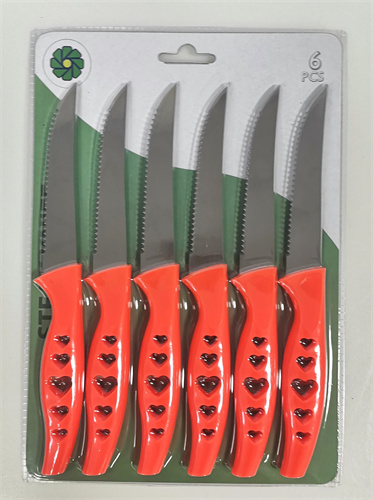
When purchasing steak knives, prioritize quality over quantity. High-quality knives made from durable materials will last longer and require less frequent sharpening. Consider investing in a reputable brand known for its craftsmanship. Researching different brands and reading reviews can help you make informed decisions about your knife purchases. A well-chosen knife can become a cherished tool in your kitchen for years to come.
Always wash your steak knives by hand with mild soap and water. Avoid using the dishwasher, as the high heat and jostling can dull the blades. After washing, dry your knives immediately to prevent rust and corrosion. Additionally, consider applying a light coat of food-safe mineral oil to the blade and handle to protect against moisture and enhance the knife's appearance. This simple step can help maintain the quality of your knives and keep them looking new.
Dull steak knives can be a significant inconvenience in the kitchen, but understanding the common causes of dullness can help you take proactive measures to maintain their sharpness. By adopting proper cutting techniques, investing in quality knives, and implementing effective storage and maintenance practices, you can ensure that your steak knives remain sharp and ready for use. Remember, a sharp knife is not only more efficient but also safer, making it an essential tool for any home cook. With the right care and attention, your steak knives can provide years of reliable service, enhancing your culinary experiences and making every meal a pleasure.
The best way to sharpen steak knives is to use a whetstone or a honing rod. A whetstone allows for precise sharpening at the correct angle, while a honing rod can help realign the blade's edge between sharpening sessions. For convenience, electric sharpeners can also be used, but they may not provide the same level of control as manual methods.
The frequency of sharpening steak knives depends on how often they are used. For regular home cooks, sharpening every few months is generally sufficient. However, if you use your knives daily or for heavy-duty tasks, you may need to sharpen them more frequently, possibly every few weeks.
It is not recommended to use a dishwasher to clean steak knives. The high heat and movement in the dishwasher can dull the blades and cause damage. Instead, wash them by hand with mild soap and water, and dry them immediately to prevent rust and corrosion.
A wooden or plastic cutting board is best for maintaining knife sharpness. These materials are softer than glass or stone, which helps prevent the knife edge from becoming dull. Wooden boards also have self-healing properties that can minimize wear on the blade.
You can tell if your steak knife is dull if it struggles to cut through meat, requires excessive force, or produces ragged edges instead of clean cuts. A sharp knife should glide through food with minimal effort. If you notice these signs, it’s time to sharpen your knife.